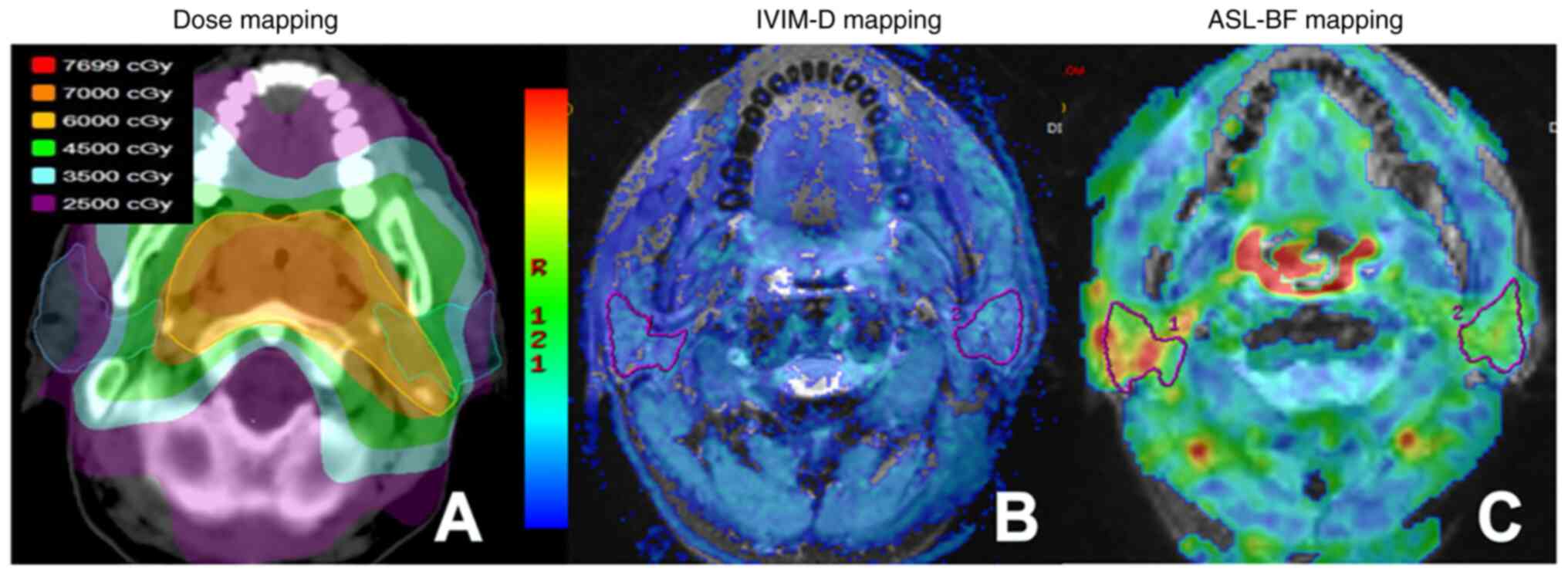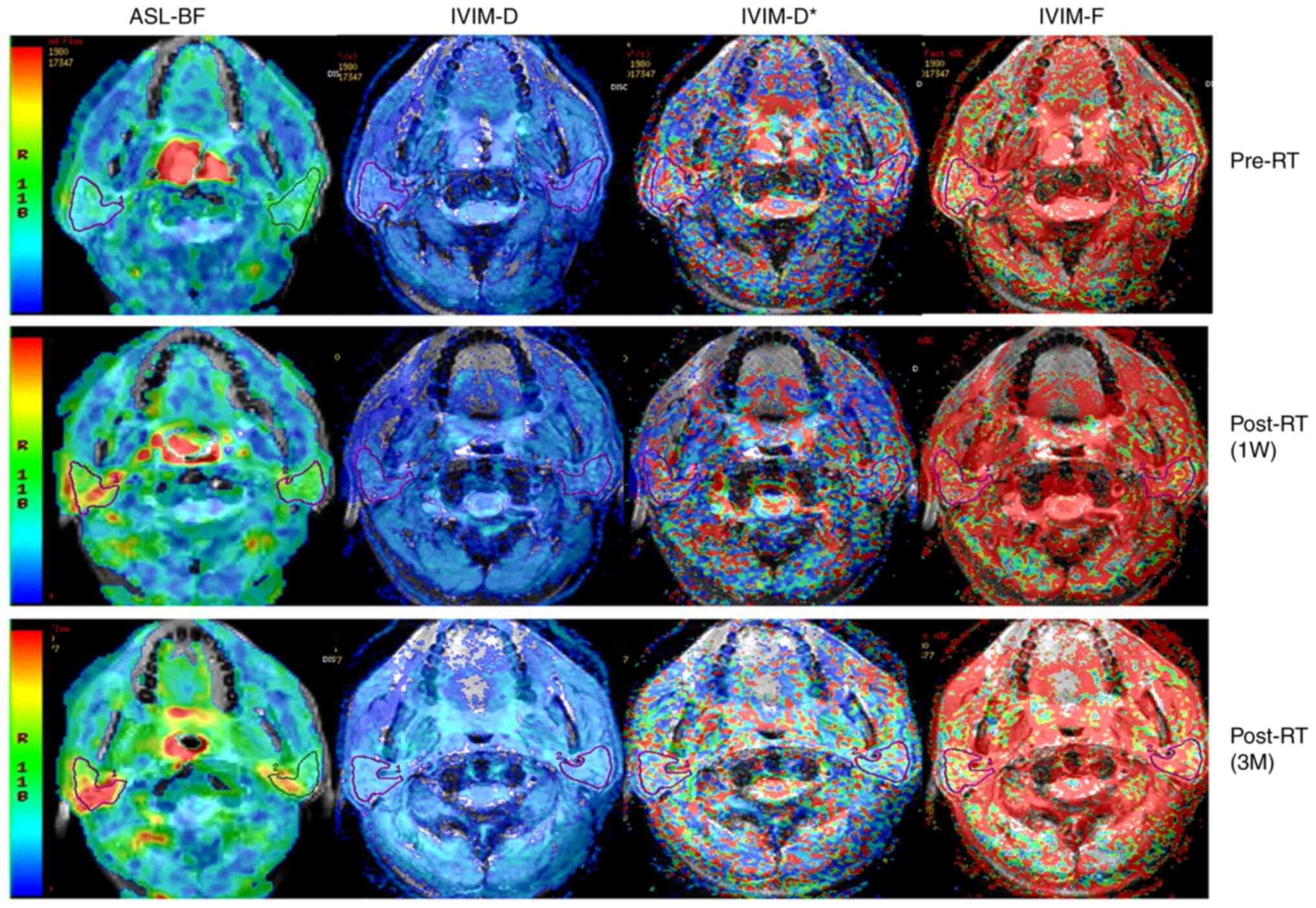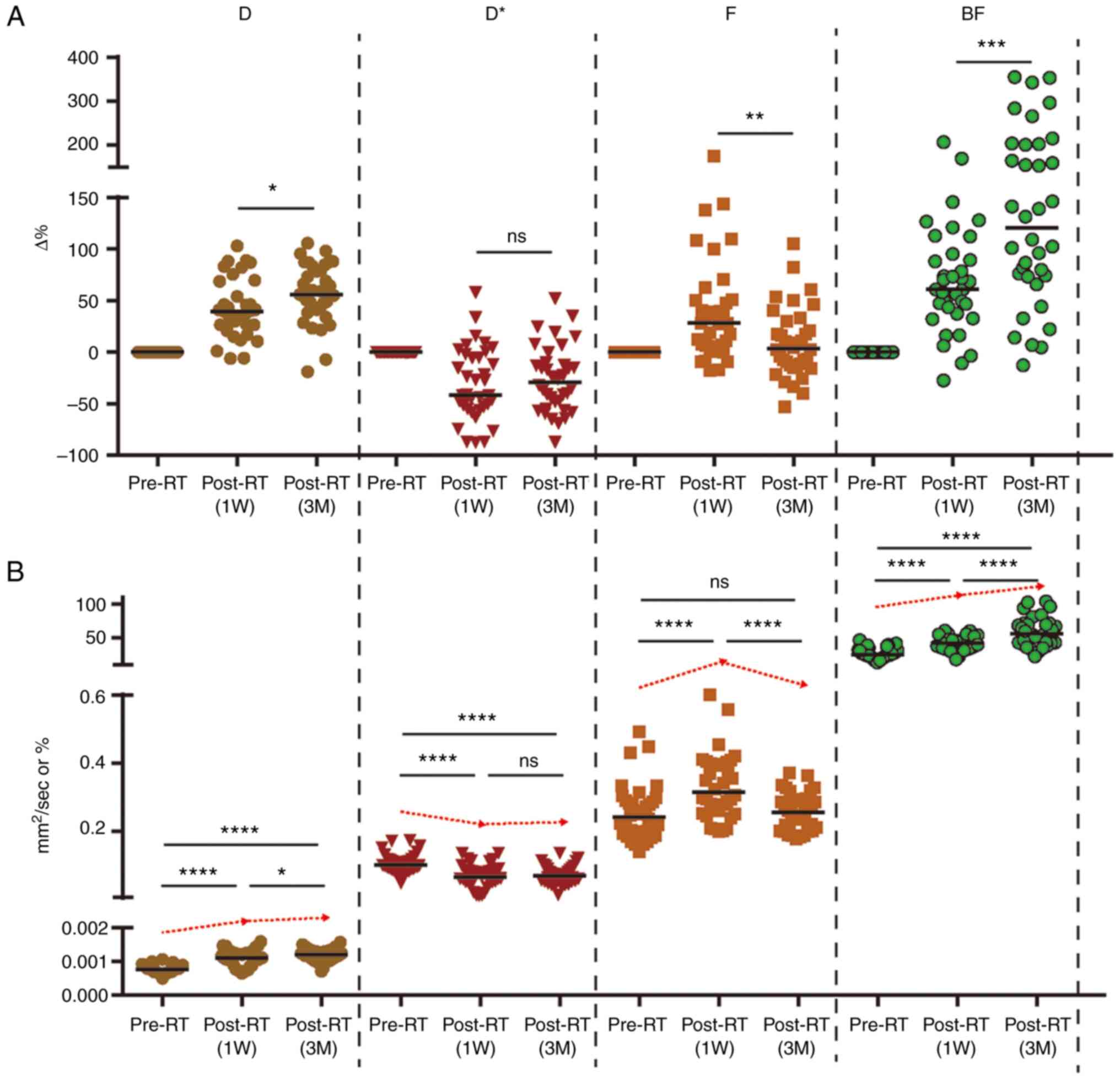|
1
|
Guo Y, Jiang W, Lakshminarayanan P, Han P,
Cheng Z, Bowers M, Hui X, Shpitser I, Siddiqui S, Taylor RH, et al:
Spatial radiation dose influence on xerostomia recovery and its
comparison to acute incidence in patients with head and neck
cancer. Adv Radiat Oncol. 5:221–230. 2019. View Article : Google Scholar : PubMed/NCBI
|
|
2
|
Wang K, Pearlstein KA, Moon DH, Mahbooba
ZM, Deal AM, Wang Y, Sutton SR, Motley BB, Judy GD, Holmes JA, et
al: Assessment of risk of xerostomia after whole-brain radiation
therapy and association with parotid dose. JAMA Oncol. 5:221–228.
2019. View Article : Google Scholar : PubMed/NCBI
|
|
3
|
Zhang T, Liu C, Ma S, Gao Y and Wang R:
Protective effect and mechanism of action of rosmarinic acid on
radiation-induced parotid gland injury in rats. Dose Response.
18:15593258209077822020. View Article : Google Scholar : PubMed/NCBI
|
|
4
|
Feng X, Wu Z, Xu J, Xu Y, Zhao B, Pang B,
Qu X, Hu L, Hu L, Fan Z, et al: Dietary nitrate supplementation
prevents radiotherapy-induced xerostomia. Elife. 10:e707102021.
View Article : Google Scholar : PubMed/NCBI
|
|
5
|
Xu J, Yan X, Gao R, Mao L, Cotrim AP,
Zheng C, Zhang C, Baum BJ and Wang S: Effect of irradiation on
microvascular endothelial cells of parotid glands in the miniature
pig. Int J Radiat Oncol Biol Phys. 78:897–903. 2010. View Article : Google Scholar : PubMed/NCBI
|
|
6
|
Fan WJ, Teng F, Luo YR, Yu W, Zhang Q, Lu
YP and Ma L: Diffusion-weighted imaging as a follow-up modality for
evaluation of major salivary gland function in nasopharyngeal
carcinoma patients: A preliminary study. Strahlenther Onkol.
196:530–541. 2020. View Article : Google Scholar : PubMed/NCBI
|
|
7
|
Juan CJ, Chen CY, Jen YM, Liu HS, Liu YJ,
Hsueh CJ, Wang CY, Chou YC, Chai YT, Huang GS and Chung HW:
Perfusion characteristics of late radiation injury of parotid
glands: Quantitative evaluation with dynamic contrast-enhanced MRI.
Eur Radiol. 19:94–102. 2009. View Article : Google Scholar : PubMed/NCBI
|
|
8
|
Xu Z, Zheng S, Pan A, Cheng X and Gao M: A
multiparametric analysis based on DCE-MRI to improve the accuracy
of parotid tumor discrimination. Eur J Nucl Med Mol Imaging.
46:2228–2234. 2019. View Article : Google Scholar : PubMed/NCBI
|
|
9
|
Wu W, Jiang G, Xu Z, Wang R, Pan A, Gao M,
Yu T, Huang L, Quan Q and Li J: Three-dimensional pulsed continuous
arterial spin labeling and intravoxel incoherent motion imaging of
nasopharyngeal carcinoma: Correlations with Ki-67 proliferation
status. Quant Imaging Med Surg. 11:1394–1405. 2021. View Article : Google Scholar : PubMed/NCBI
|
|
10
|
Li Y, Lin CY, Qi YF, Wang X, Chen B, Zhou
HL, Ren J, Yang JJ, Xiang Y, He YL, et al: Three-dimensional
turbo-spin-echo amide proton transfer-weighted and intravoxel
incoherent motion MR imaging for type I endometrial carcinoma:
Correlation with Ki-67 proliferation status. Magn Reson Imaging.
78:18–24. 2021. View Article : Google Scholar : PubMed/NCBI
|
|
11
|
Yu YM, Wang W, Wen J, Zhang Y, Lu GM and
Zhang LJ: Detection of renal allograft fibrosis with MRI: Arterial
spin labeling outperforms reduced field-of-view IVIM. Eur Radiol.
31:6696–6707. 2021. View Article : Google Scholar : PubMed/NCBI
|
|
12
|
Poynton CB, Lee MM, Li Y, Laszik Z,
Worters PW, Mackenzie JD and Courtier J: Intravoxel incoherent
motion analysis of renal allograft diffusion with clinical and
histopathological correlation in pediatric kidney transplant
patients: A preliminary cross-sectional observational study.
Pediatr Transplant. 21:e129962017. View Article : Google Scholar : PubMed/NCBI
|
|
13
|
Jia QJ, Zhang SX, Chen WB, Liang L, Zhou
ZG, Qiu QH, Liu ZY, Zeng QX and Liang CH: Initial experience of
correlating parameters of intravoxel incoherent motion and dynamic
contrast-enhanced magnetic resonance imaging at 3.0 T in
nasopharyngeal carcinoma. Eur Radiol. 24:3076–3087. 2014.
View Article : Google Scholar : PubMed/NCBI
|
|
14
|
Kang M, Zhou P, Li G, Yan H and Wang R:
Validation of the 8th edition of the UICC/AJCC staging system for
nasopharyngeal carcinoma treated with intensity-modulated
radiotherapy. Oncotarget. 8:70586–70594. 2017. View Article : Google Scholar : PubMed/NCBI
|
|
15
|
Chinese Committee for Staging of
Nasopharyngeal Carcinoma, . The 2017 edition for staging of
nasopharyngeal carcinoma in China (The Chinese 2008 expert
consensus on staging revision of nasopharyngeal carcinoma). Chinese
J Radiation Oncology. 26:1119–1124. 2017.(In Chinese).
|
|
16
|
Westgaard KL, Hynne H, Amdal CD, Young A,
Singh PB, Chen X, Rykke M, Hove LH, Aqrawi LA, Utheim TP, et al:
Oral and ocular late effects in head and neck cancer patients
treated with radiotherapy. Sci Rep. 11:40262021. View Article : Google Scholar : PubMed/NCBI
|
|
17
|
Acauan MD, Figueiredo MA, Cherubini K,
Gomes AP and Salum FG: Radiotherapy-induced salivary dysfunction:
Structural changes, pathogenetic mechanisms and therapies. Arch
Oral Biol. 60:1802–1810. 2015. View Article : Google Scholar : PubMed/NCBI
|
|
18
|
Wu VWC, Ying MT, Kwong DL, Khong PL, Wong
GK and Tam SY: A longitudinal study on parotid and submandibular
gland changes assessed by magnetic resonance imaging and
ultrasonography in post-radiotherapy nasopharyngeal cancer
patients. BJR Open. 2:202000032020.PubMed/NCBI
|
|
19
|
Hu S, Gao Y, Zhou H, Kong F, Xiao F, Zhou
P and Chen Y: New insight into mitochondrial changes in vascular
endothelial cells irradiated by gamma ray. Int J Radiat Biol.
93:470–476. 2017. View Article : Google Scholar : PubMed/NCBI
|
|
20
|
Fajardo LF: The pathology of ionizing
radiation as defined by morphologic patterns. Acta Oncol. 44:13–22.
2005. View Article : Google Scholar : PubMed/NCBI
|
|
21
|
Boström M, Kalm M, Eriksson Y, Bull C,
Ståhlberg A, Björk-Eriksson T, Hellström Erkenstam N and Blomgren
K: A role for endothelial cells in radiation-induced inflammation.
Int J Radiat Biol. 94:259–271. 2018. View Article : Google Scholar : PubMed/NCBI
|
|
22
|
Lee FK, King AD, Kam MK, Ma BB and Yeung
DK: Radiation injury of the parotid glands during treatment for
head and neck cancer: Assessment using dynamic contrast-enhanced MR
imaging. Radiat Res. 175:291–296. 2011. View Article : Google Scholar : PubMed/NCBI
|
|
23
|
Bisdas S, Koh TS, Roder C, Braun C,
Schittenhelm J, Ernemann U and Klose U: Intravoxel incoherent
motion diffusion-weighted MR imaging of gliomas: Feasibility of the
method and initial results. Neuroradiology. 55:1189–1196. 2013.
View Article : Google Scholar : PubMed/NCBI
|
|
24
|
Marzi S, Forina C, Marucci L, Giovinazzo
G, Giordano C, Piludu F, Landoni V, Spriano G and Vidiri A: Early
radiation-induced changes evaluated by intravoxel incoherent motion
in the major salivary glands. J Magn Reson Imaging. 41:974–982.
2015. View Article : Google Scholar : PubMed/NCBI
|
|
25
|
Shen N, Zhao L, Jiang J, Jiang R, Su C,
Zhang S, Tang X and Zhu W: Intravoxel incoherent motion
diffusion-weighted imaging analysis of diffusion and microperfusion
in grading gliomas and comparison with arterial spin labeling for
evaluation of tumor perfusion. J Magn Reson Imaging. 44:620–632.
2016. View Article : Google Scholar : PubMed/NCBI
|
|
26
|
Dolgorsuren EA, Harada M, Kanazawa Y, Abe
T, Otomo M, Matsumoto Y, Mizobuchi Y and Nakajima K: Correlation
and characteristics of intravoxel incoherent motion and arterial
spin labeling techniques versus multiple parameters obtained on
dynamic susceptibility contrast perfusion MRI for brain tumors. J
Med Invest. 66:308–313. 2019. View Article : Google Scholar : PubMed/NCBI
|
|
27
|
van Dijk LV, Thor M, Steenbakkers RJHM,
Apte A, Zhai TT, Borra R, Noordzij W, Estilo C, Lee N, Langendijk
JA, et al: Parotid gland fat related Magnetic Resonance image
biomarkers improve prediction of late radiation-induced xerostomia.
Radiother Oncol. 128:459–466. 2018. View Article : Google Scholar : PubMed/NCBI
|
|
28
|
Zhang L, Murata Y, Ishida R, Ohashi I,
Yoshimura R and Shibuya H: Functional evaluation with intravoxel
incoherent motion echo-planar MRI in irradiated salivary glands: A
correlative study with salivary gland scintigraphy. J Magn Reson
Imaging. 14:223–229. 2001. View Article : Google Scholar : PubMed/NCBI
|
|
29
|
Hey J, Setz J, Gerlach R, Janich M,
Hildebrandt G, Vordermark D, Gernhardt CR and Kuhnt T: Parotid
gland-recovery after radiotherapy in the head and neck region-36
months follow-up of a prospective clinical study. Radiat Oncol.
6:1252011. View Article : Google Scholar : PubMed/NCBI
|












